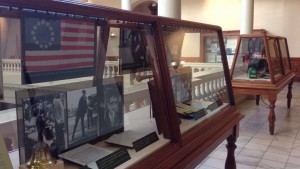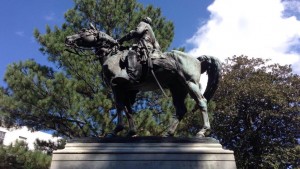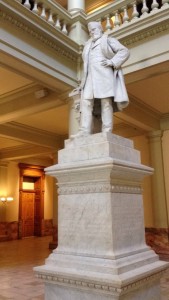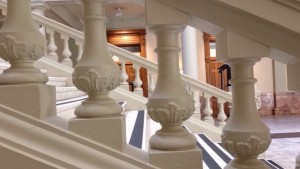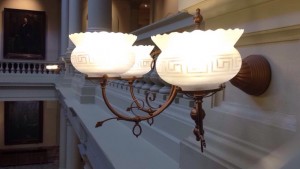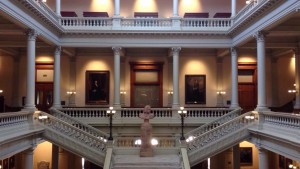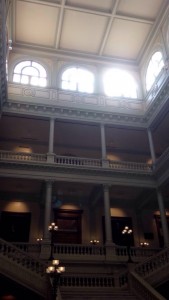The second floor of the capital building houses many historical artifacts and exhibits relevant to Georgia’s history. This floor felt the most like a museum. The wooden and glass cases held everything fro memorial bells to journal entries from past Governors and other important historical figures. I spent most of my time on this floor, looking at all of the artifacts on display. I was surprised at how interesting this floor was. It added even more to the sense of pride in the state of Georgia that the building imposes.
Tag Archives: Capital Building
Built Environment Description: Georgia State Capital Building (BED1)
Located several blocks from the southeast corner of downtown Atlanta, Georgia’s capital building by all means stands out amongst the buildings surrounding it. Amidst the skyscrapers, highways, and structures, I can always see the bright golden dome from my dorm room on the 11th floor of the GA State University Commons. I picked this building for my built environment description because it was always so interesting to look at from afar and I had never actually gone there even though I’ve lived in Georgia almost my entire life. And now that it is a mere 15 minute walk from my dorm, I had no excuse not to go.
The design of the capital building demands attention. As I came closer and closer to the building, its dominance on the surrounding environment was becoming increasingly clearer. As I got closer and closer it became harder for me to look away from the huge golden dome. I noticed this effect taking place in the eyes of other pedestrians, who either came to a full stop to take pictures, or otherwise couldn’t detach their eyes from the structure.
The area surrounding the building is comprised of large green yards and trees provide a lot of shade. This area is somewhat like a public park and a history museum in one, with statues and other historical artifacts around every corner. I saw one woman taking advantage of this rare area of shade in the city and eating lunch under a huge tree.
The interior of the building is very spacious and defined. Everything I saw inside had a clear cut purpose for being there. The offices of Secretary of State and the Governor’s office were the first offices I saw, right next to the large wooden front door. I suppose this made these two officials seem more easily accessible to the public. The wide open atriums are strictly symmetrical and homogeneous. When I was there, at around 3:00 in the afternoon, most of the light in the building came from the huge windows lining the top of the walls. Thick white columns run from the first floor to the top, and the dark brown wooden doors of offices line the walls of each floor. Countless marble statues, busts and historical artifacts can be found anywhere in the building. Overall, the capital building gave off a sense that it was a place where Georgia’s history is concentrated and positively furthered through the work of the state government.
Georgia State Capital Building: Statues (BED1)
There are countless statues and busts all throughout the interior and exterior of the building commemorating the important historical figures significant to Georgia, all of which give the environment a strong sense of historical reverence. The equestrian statue above honors John Brown Gordon, one of Robert E. Lee’s most trusted Confederate generals during the American Civil War, a titular leader of the Ku Klux Klan in Georgia, and a strong opponent of Reconstruction. The marble statue on the right commemorates Benjamin Harvey Hill, a senator highly opposed to southern secession who held many seats in Georgia state government during the late 1800’s.
Georgia State Capital Building: Design Details (BED1)
The furnishings of the interior were all very detailed. The stair railings above were decorated with ornate etchings and lavish spiral ends. The lighting fixtures were embellished with these stem-like decorations and precise design details. Some lighting fixtures near the ends of the stairs were designed like colonial-era lamp posts.
Georiga State Capital Building: Interior (BED1)
The interior of the building is very expansive, almost cavernous. If you listen closely to the video you may be able to hear my footsteps and other noises echoing off of the tall walls and corridors. The building feels a lot bigger inside than it looks from the outside. You can also see that most of the light comes from the huge windows near the ceiling. There was clearly an emphasis on symmetry and uniformity across the interior design, as each floor looks like the last and one side of the room looks exactly like the other. And perhaps it was merely the time I was there, but for all these offices I saw maybe 15 people in the entire building.
Georgia State Capital Building: The Dome (BED1)


The bright golden dome of the capital building is by far the most eye-catching feature of the building’s appearance from the outside. The environment surrounding the building itself is like a public park and a history museum in one. There are relatively wide open grassy areas, trees provide a lot of shade, and there are many statues of historical figures around every corner. The dome itself is an interesting architectural and historical artifact. There are actually stairs between the inner and outer dome where people used to be able to climb to the cupola, the cylindrical area between the statue of Miss Freedom and the outer dome. Before the stairs were closed for safety reasons in the 1950’s, almost 400 people attempted the 232 step climb each day to see panoramic views of the city.

